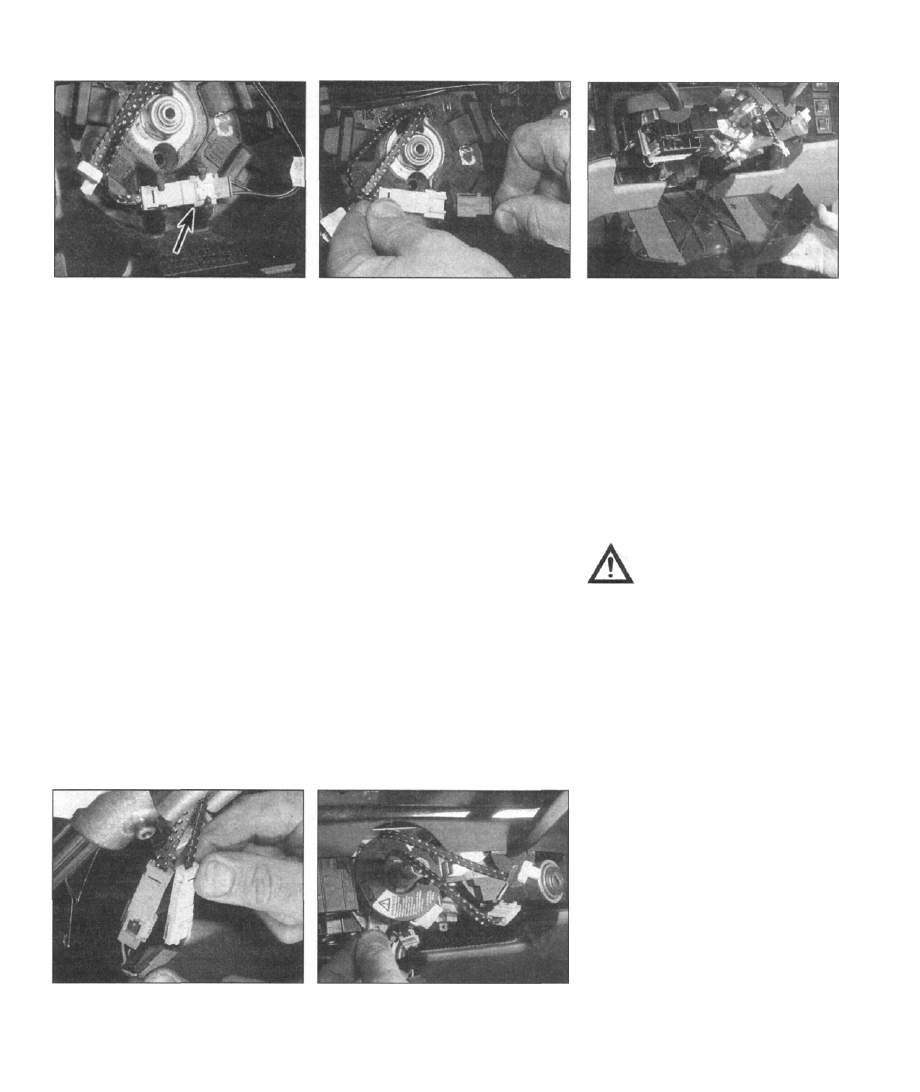SAAB 9000. Manual - part 52

11 •24 Bodywork and fittings
28.17a Prise the horn cable connector out
of the mounting bracket on the steering
wheel casting (arrowed)...
9 Prise out the plastic caps from the retaining
screws on the lower front panel, then remove
the screws.
10 Pull the lower panel away from the facia,
releasing the clips one at a time.
11 Unplug the airbag module wiring at the
connector.
12 Remove the four airbag module retaining
screws, then reach inside the facia, grasp the
module from behind and carefully draw it out,
whilst releasing it from the mounting clips.
Refitting
13 Refit the airbag by reversing the removal
procedure; observe the specified torque
wrench setting when tightening the airbag and
lower cover panel retaining screws.
14 Reconnect the battery negative cable, and
turn the ignition switch to the "Drive" or "Start"
position. Check the condition of the system by
observing the SRS warning light; refer to the
"General Information" sub-section to interpret
the results obtained.
Steering wheel rotary contact unit
Removal
15 Disconnect the battery negative cable,
and wait at least twenty minutes before
progressing any further; refer to the Warnings
listed in the "General Information" sub-section
for more detail.
28.17b . . . and unplug it, labelling the cable
to aid refitting later
16 Remove the driver's airbag module, as
described earlier in this Section.
17 Prise the horn cable connector out of the
mounting bracket on the steering wheel
casting and unplug it, labelling the cable to aid
refitting later (see illustrations).
18 Set the steering in the straight-ahead
position, then refer to Chapter 10 and remove
the steering wheel, feeding the cable
connectors through the hole in the steering
wheel casting.
19 Remove the retaining screws, and lift the
upper and lower cowling panels away from the
steering column (see illustration).
20 Unplug the contact unit and horn cables at
the connectors, after cutting through the
cable-tie securing them to the ignition
switch/lock assembly (see illustration). Label
the cables, to aid refitting later.
21 Slacken and withdraw the retaining
screws, then lift the contact unit off the
steering column (see illustration). Take great
care to ensure that the two halves of the
contact unit are not rotated whilst it is
separated from the steering column.
Refitting
22 Guide the contact unit onto the steering
column, then refit and tighten the retaining
screws.
23 Plug the horn and contact unit connectors
28.20 Unplug the contact unit and horn
cables at the connectors, after cutting
through the cable-tie securing them to the
ignition switch/lock assembly
28.21 Slacken and withdraw the retaining
screws, then lift the contact unit off the
steering column
28.19 Removing the lower cowling panel
from the steering column
together, then secure them to the ignition
switch/lock assembly with a cable-tie.
24 Refit the upper and lower steering column
cowling panels, and tighten the retaining
screws.
25 Align the contact unit with the steering
wheel as follows. Check that the front
roadwheels are still in the straight-ahead
position. Rotate the upper section of the
contact unit fully anti-clockwise, until it is felt
to touch its end stop. Note: Ensure that the
direction indicator stalk is in the "off" position,
otherwise the cancelling mechanism may
affect the alignment accuracy.
Caution: Do not apply excessive
force during this operation; the
contact unit has very fragile
internal components. Now rotate
the contact unit clockwise by the number
of turns printed on the unit's label (either
2.5 or 3.5 turns) - ensure that the unit is
now kept in this position until the steering
wheel is refitted.
26 Offer up the steering wheel to the steering
column, and feed the cable connectors
through the hole in the wheel casting. Engage
the spigot protruding from the contact unit
with the alignment hole in the steering wheel
casting - ensure that the wheel is fitted
squarely in the straight-ahead position; the
contact unit may be rotated slightly to allow
the alignment spigot to engage, if necessary.
27 Fit a new steering wheel centre nut and
tighten it to the specified torque, referring to
Chapter 10 for details.
28 Plug together the horn cable connector,
and then press the connector housing into the
mounting provided in the steering wheel
casting.
29 Refit the airbag, as described earlier in this
Section.
30 Reconnect the battery negative cable, and
turn the ignition switch to the "Drive" or "Start"
position. Check the condition of the system by
observing the SRS warning light; refer to the
"General Information" sub-section to interpret
the results obtained.